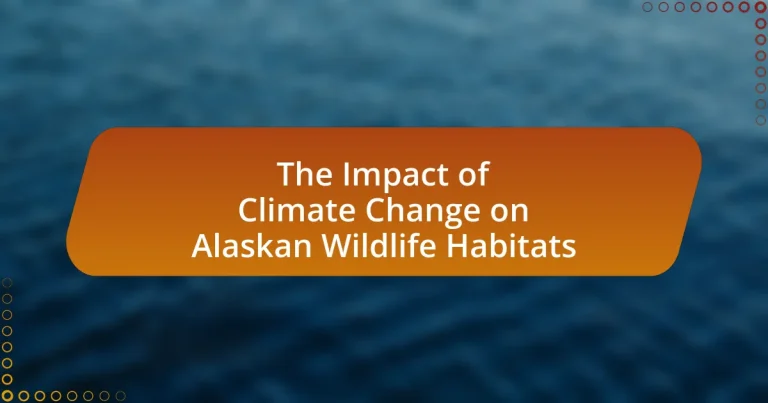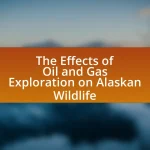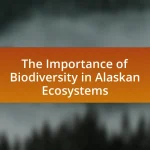The article examines the significant impact of climate change on Alaskan wildlife habitats, highlighting how rising temperatures, altered precipitation patterns, and melting sea ice threaten biodiversity. Key species such as polar bears, caribou, and migratory birds are particularly affected, facing habitat loss and disrupted food sources. The article also discusses the broader ecological consequences, including shifts in species distribution and the destabilization of ecosystems. Additionally, it addresses the role of local communities in conservation efforts and the importance of public awareness in mitigating climate change impacts on wildlife habitats.
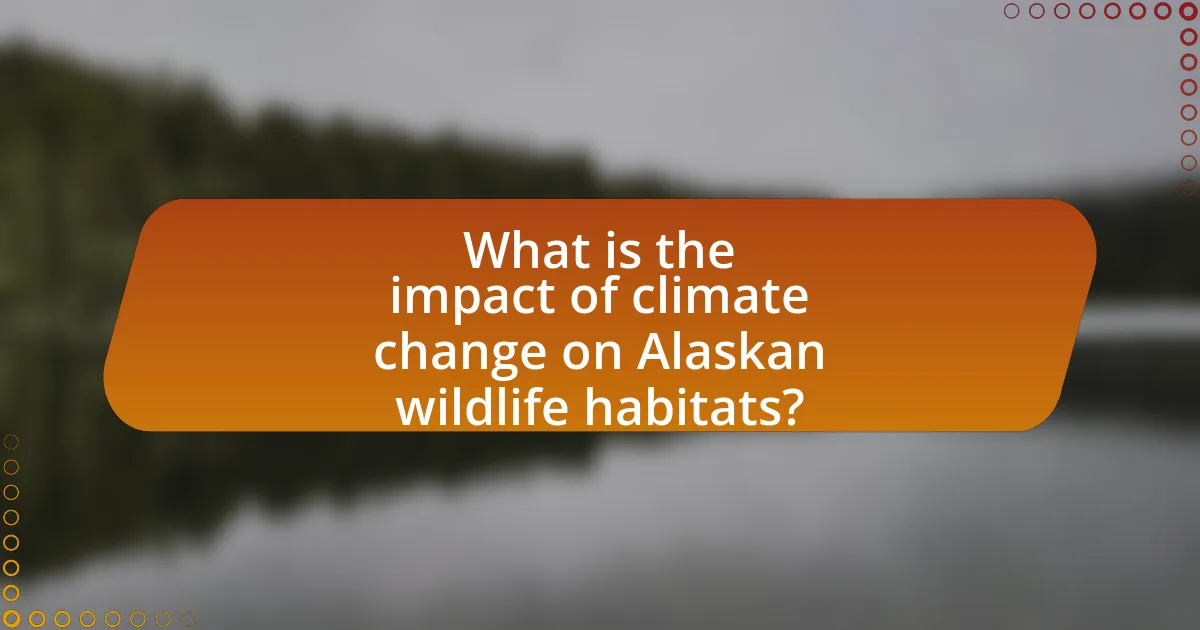
What is the impact of climate change on Alaskan wildlife habitats?
Climate change significantly alters Alaskan wildlife habitats by causing shifts in temperature, precipitation patterns, and sea ice extent. These changes lead to habitat loss for species such as polar bears and seals, which rely on sea ice for hunting and breeding. Additionally, warming temperatures affect the distribution of plant species, which in turn impacts herbivores like caribou and moose, as their food sources become less available or shift to different areas. Research indicates that by 2050, Alaska could see a temperature increase of up to 6 degrees Fahrenheit, further exacerbating these habitat changes and threatening biodiversity.
How does climate change affect the temperature and weather patterns in Alaska?
Climate change significantly increases temperatures and alters weather patterns in Alaska. Average temperatures in Alaska have risen by approximately 3°F (1.6°C) since the late 20th century, with projections indicating further increases of 4°F to 8°F (2.2°C to 4.4°C) by the end of the century. This warming leads to more frequent and intense weather events, such as heavy rainfall and storms, while also causing shifts in seasonal patterns, including earlier springs and delayed winters. The National Oceanic and Atmospheric Administration (NOAA) reports that these changes disrupt ecosystems, affecting wildlife habitats and species distribution, as many species struggle to adapt to the rapid environmental changes.
What are the specific temperature changes observed in Alaskan regions?
Alaskan regions have experienced significant temperature increases, with an average rise of approximately 3°F (1.6°C) over the past 60 years. This warming trend is particularly pronounced in the Arctic, where temperatures have increased by about 5°F (2.8°C) since the 1970s. The National Oceanic and Atmospheric Administration (NOAA) reports that Alaska is warming at nearly twice the rate of the global average, leading to altered ecosystems and wildlife habitats. These temperature changes have resulted in earlier snowmelt, thawing permafrost, and shifts in species distributions, impacting both terrestrial and marine wildlife.
How do altered weather patterns influence wildlife habitats?
Altered weather patterns significantly influence wildlife habitats by changing temperature, precipitation, and seasonal cycles. These changes can lead to habitat loss, shifts in species distribution, and altered food availability. For instance, in Alaska, rising temperatures have resulted in the melting of permafrost, which disrupts the habitats of species like caribou and migratory birds. Additionally, altered precipitation patterns can affect the growth of vegetation, impacting herbivores and the predators that rely on them. Research indicates that these shifts can lead to mismatches in timing between species and their food sources, further threatening wildlife populations.
What types of wildlife are most affected by climate change in Alaska?
Climate change in Alaska most significantly affects polar bears, caribou, and migratory birds. Polar bears are losing sea ice habitat due to rising temperatures, which impacts their hunting and breeding. Caribou populations are experiencing changes in migration patterns and food availability, linked to altered vegetation growth from warming temperatures. Migratory birds face disruptions in their breeding and feeding grounds, as climate change affects the timing of seasonal changes and food sources. These impacts are supported by research indicating that rising temperatures in Alaska are leading to habitat loss and altered ecosystems, which directly threaten these wildlife species.
Which species are at the highest risk due to habitat changes?
Polar bears, caribou, and various species of salmon are at the highest risk due to habitat changes in Alaska. Polar bears are threatened by the loss of sea ice, which is critical for their hunting and breeding. Caribou populations are declining as their migratory routes are disrupted by changing landscapes and vegetation. Salmon species face challenges from altered river temperatures and flow patterns, impacting their spawning habitats. These species are indicators of the broader ecological shifts occurring in Alaskan wildlife habitats due to climate change.
How does climate change impact migratory patterns of Alaskan wildlife?
Climate change significantly alters the migratory patterns of Alaskan wildlife by affecting the timing and routes of migration. Warmer temperatures lead to earlier snowmelt and changes in vegetation growth, which can disrupt the availability of food sources for species such as caribou and migratory birds. For instance, studies have shown that the migration of caribou herds has shifted by several weeks earlier in spring due to increased temperatures, impacting their calving success rates. Additionally, altered weather patterns can create barriers or change the habitats that wildlife rely on during migration, further complicating their traditional routes.
What are the broader ecological consequences of climate change on Alaskan habitats?
Climate change significantly alters Alaskan habitats, leading to shifts in species distribution, loss of biodiversity, and changes in ecosystem dynamics. For instance, rising temperatures cause permafrost thawing, which disrupts the habitats of species like caribou and migratory birds. Additionally, altered precipitation patterns affect freshwater availability, impacting aquatic ecosystems and the species that depend on them. According to the U.S. Geological Survey, these changes can lead to a decline in native species and the proliferation of invasive species, further threatening ecological balance.
How does the loss of ice and snow cover affect ecosystems?
The loss of ice and snow cover significantly disrupts ecosystems by altering habitat availability and species interactions. As ice and snow retreat, species that depend on these conditions, such as polar bears and seals, face habitat loss, leading to decreased populations. Additionally, the melting ice contributes to rising sea levels, which can inundate coastal habitats and further threaten biodiversity. Research indicates that the decline in snow cover affects plant growth cycles, which in turn impacts herbivores and the predators that rely on them, creating a cascading effect throughout the food web. For instance, studies show that the reduction of snow cover in Alaska has led to changes in vegetation patterns, affecting species like caribou that depend on specific plant types for sustenance.
What role do plant species play in the changing wildlife habitats?
Plant species are crucial in shaping and transforming wildlife habitats, particularly in the context of climate change. As climate conditions shift, plant species adapt by altering their distribution, growth patterns, and phenology, which directly influences the availability of food and shelter for various wildlife species. For instance, in Alaska, the northward migration of plant species due to rising temperatures has led to changes in habitat structure, affecting species such as caribou and migratory birds that rely on specific vegetation types for foraging and nesting. Research indicates that as plant communities shift, they can either enhance or diminish habitat quality for wildlife, thereby impacting biodiversity and ecosystem health.
How are local communities responding to the impacts of climate change on wildlife?
Local communities in Alaska are actively responding to the impacts of climate change on wildlife by implementing conservation initiatives and adapting traditional practices. For instance, Indigenous groups are utilizing traditional ecological knowledge to monitor wildlife populations and habitat changes, ensuring sustainable hunting and fishing practices. Additionally, community-led projects focus on habitat restoration and the establishment of protected areas to safeguard vulnerable species. Research indicates that these local efforts are crucial, as they enhance resilience against climate-related disruptions, with studies showing that Indigenous management practices can lead to improved biodiversity outcomes.
What conservation efforts are being implemented to protect Alaskan wildlife habitats?
Conservation efforts to protect Alaskan wildlife habitats include the establishment of protected areas, habitat restoration projects, and wildlife management programs. The Alaska National Wildlife Refuge, for example, safeguards diverse ecosystems critical for species such as polar bears and migratory birds. Additionally, initiatives like the Alaska Coastal Management Program focus on preserving coastal habitats from development and pollution. These efforts are supported by scientific research, such as studies conducted by the U.S. Fish and Wildlife Service, which highlight the importance of maintaining biodiversity and ecosystem health in the face of climate change.
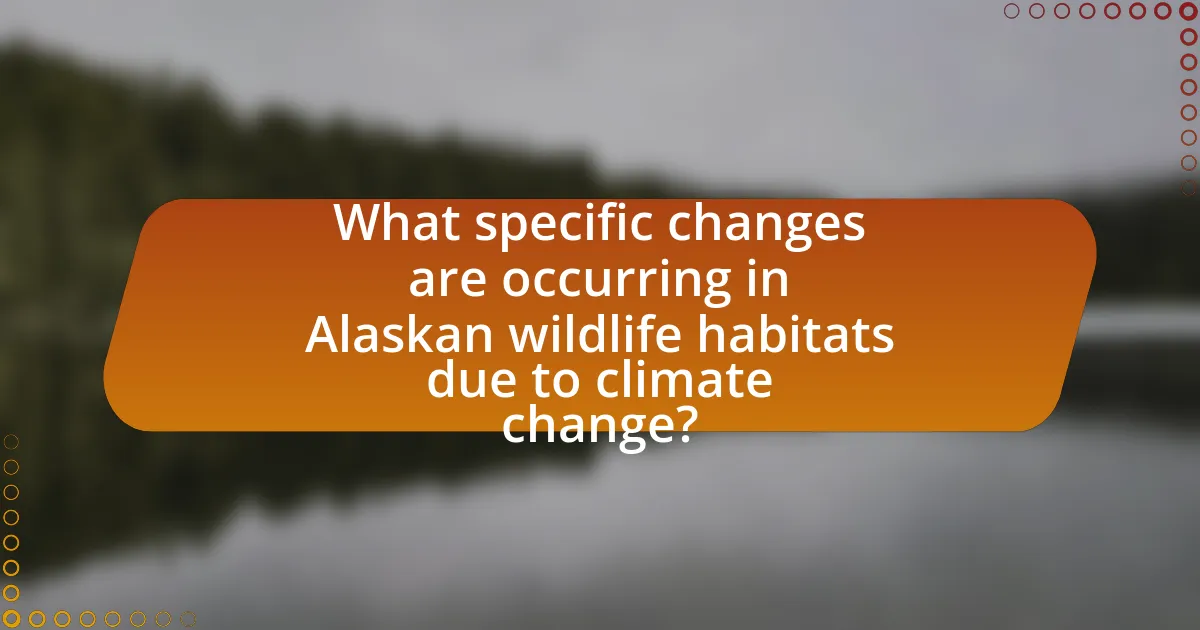
What specific changes are occurring in Alaskan wildlife habitats due to climate change?
Climate change is causing significant alterations in Alaskan wildlife habitats, primarily through rising temperatures, shifting vegetation zones, and changing precipitation patterns. For instance, average temperatures in Alaska have increased by approximately 3°F since the late 20th century, leading to the northward migration of species such as moose and caribou as they seek cooler environments. Additionally, the warming climate is resulting in the thawing of permafrost, which disrupts the habitats of species like the Arctic fox and migratory birds that rely on stable ground conditions for nesting. Furthermore, altered precipitation patterns are affecting the availability of freshwater resources, impacting fish populations and the ecosystems that depend on them. These changes collectively threaten biodiversity and the ecological balance within Alaskan habitats.
How is permafrost thawing affecting wildlife habitats?
Permafrost thawing is significantly altering wildlife habitats by destabilizing the ground and changing the availability of water resources. As permafrost thaws, it leads to the formation of thermokarst, which creates uneven terrain and disrupts the habitats of species such as caribou and migratory birds. Additionally, the release of greenhouse gases from thawing permafrost can further exacerbate climate change, leading to shifts in vegetation patterns that affect food sources for various wildlife. Studies indicate that these changes can result in decreased biodiversity and altered migration patterns, impacting the overall ecosystem balance in Alaskan regions.
What are the implications of permafrost thaw for animal burrows and nesting sites?
Permafrost thaw significantly destabilizes animal burrows and nesting sites, leading to increased vulnerability for various species. As permafrost melts, the ground becomes softer and less supportive, causing burrows to collapse and nesting sites to become unsuitable. Research indicates that species such as Arctic ground squirrels and seabirds are particularly affected, as their habitats rely on stable, frozen ground for structural integrity. Additionally, the loss of permafrost can alter local ecosystems, impacting food availability and predator-prey dynamics, further threatening the survival of these animals.
How does thawing permafrost influence plant growth and habitat availability?
Thawing permafrost significantly enhances plant growth and habitat availability by releasing nutrients and increasing soil moisture. As permafrost thaws, it transforms previously frozen ground into a more fertile environment, allowing for the proliferation of various plant species. Research indicates that thawed permafrost can lead to a 30% increase in plant biomass in some regions, as observed in studies conducted in Alaska. This increase in vegetation not only supports a wider range of plant life but also provides improved habitats for wildlife, as diverse plant communities can sustain more animal species.
What changes are observed in aquatic habitats due to climate change?
Aquatic habitats are experiencing significant changes due to climate change, primarily characterized by rising water temperatures, altered salinity levels, and shifts in species distribution. For instance, increased temperatures can lead to thermal stratification, which affects oxygen levels and disrupts aquatic ecosystems. Additionally, melting glaciers and increased precipitation contribute to changes in salinity, impacting species such as salmon that rely on specific salinity conditions for spawning. Research indicates that these changes can result in the migration of fish species northward, as observed in Alaskan waters, where species like cod and pollock are moving to cooler areas, thereby altering the entire food web.
How do rising water temperatures affect fish populations?
Rising water temperatures negatively affect fish populations by altering their habitats, reproductive cycles, and food availability. As temperatures increase, many fish species experience stress, leading to reduced growth rates and higher mortality. For instance, studies show that salmon, a key species in Alaskan waters, are particularly vulnerable; warmer waters can disrupt their spawning migrations and decrease their survival rates. Additionally, higher temperatures can lead to the proliferation of harmful algal blooms, which further deplete oxygen levels and threaten fish health. Research indicates that these changes can result in shifts in fish distribution, with some species moving to cooler waters, thereby impacting the entire aquatic ecosystem.
What impact does melting glaciers have on freshwater ecosystems?
Melting glaciers significantly disrupt freshwater ecosystems by altering water temperature, flow patterns, and nutrient availability. As glaciers retreat, the immediate influx of cold meltwater can initially increase streamflow, but over time, reduced glacier mass leads to decreased water supply during warmer months, affecting aquatic habitats. Research indicates that this change in hydrology can lead to shifts in species composition, as temperature-sensitive organisms struggle to adapt to warmer conditions. For instance, studies have shown that salmon populations, which rely on cold, glacial-fed streams for spawning, are declining in areas where glaciers have receded. This decline in salmon not only impacts the species itself but also affects the entire food web, as many terrestrial and aquatic animals depend on salmon as a food source.
How is the distribution of species changing in response to climate change?
The distribution of species is shifting northward and to higher elevations in response to climate change. This phenomenon is driven by rising temperatures, which alter habitats and affect species’ survival and reproduction. For instance, studies indicate that many bird species in Alaska are moving their breeding ranges northward by an average of 30 miles per decade, as documented in research published by the U.S. Geological Survey. Additionally, terrestrial mammals like caribou are also adapting their migratory patterns due to changing vegetation and snow conditions, further illustrating the impact of climate change on species distribution.
What factors are driving the migration of species to new areas?
Climate change is driving the migration of species to new areas primarily due to rising temperatures, altered precipitation patterns, and habitat loss. As temperatures increase, many species are shifting their ranges poleward or to higher elevations in search of suitable climates. For instance, studies have shown that Arctic species are moving northward as their habitats warm, with some fish species in Alaskan waters migrating to cooler areas. Additionally, changes in precipitation affect food availability and water resources, prompting species to relocate. Habitat loss, driven by climate change impacts such as melting ice and changing ecosystems, further compels species to seek new environments for survival.
How does the introduction of new species affect existing wildlife?
The introduction of new species can significantly disrupt existing wildlife by altering ecosystems, competing for resources, and introducing diseases. For instance, invasive species often outcompete native species for food and habitat, leading to declines in native populations. A notable example is the introduction of the Arctic cod in Alaskan waters, which has affected the food web and the survival of native fish species. Additionally, new species can bring pathogens that native wildlife have no immunity against, further threatening their populations. Studies have shown that invasive species can lead to a loss of biodiversity, which is critical for ecosystem resilience.
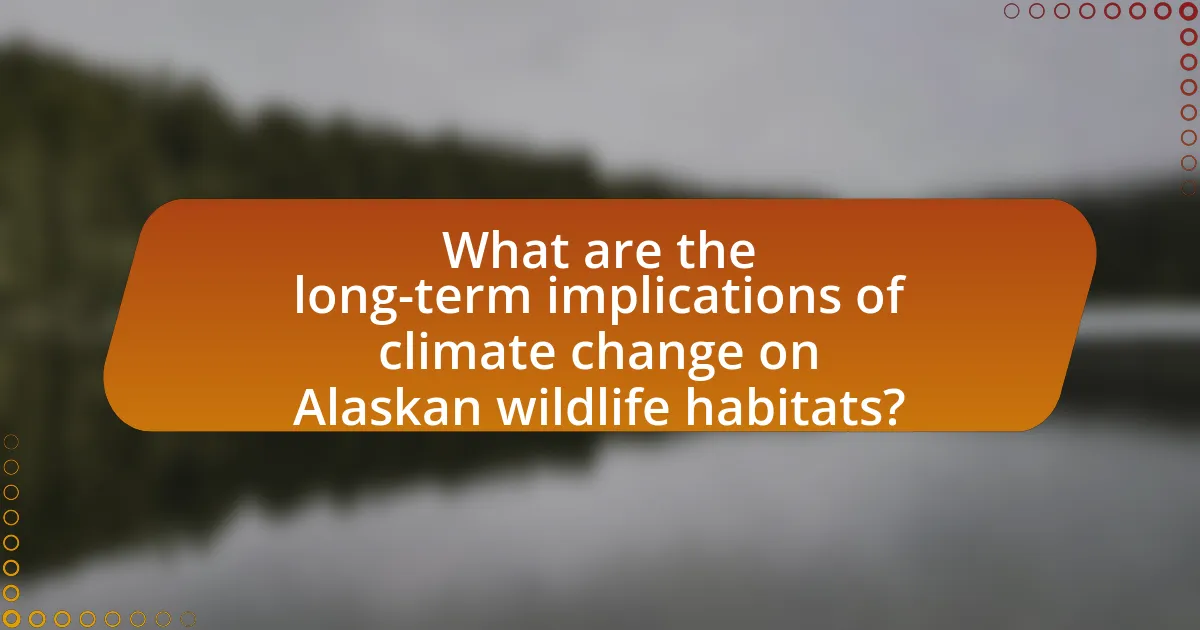
What are the long-term implications of climate change on Alaskan wildlife habitats?
Climate change has significant long-term implications for Alaskan wildlife habitats, primarily through habitat loss, altered ecosystems, and species migration. As temperatures rise, permafrost thaws, leading to changes in vegetation and the availability of food sources for wildlife. For instance, the loss of sea ice affects polar bears and seals, disrupting their hunting grounds and breeding habitats. Additionally, changing precipitation patterns can lead to increased flooding or drought, further stressing ecosystems. Research indicates that species such as caribou and migratory birds are shifting their ranges northward in response to these changes, which can lead to increased competition for resources and potential declines in certain populations. The cumulative effects of these changes threaten biodiversity and the overall health of Alaskan ecosystems.
How might future climate scenarios further impact wildlife habitats?
Future climate scenarios may significantly alter wildlife habitats by causing shifts in temperature and precipitation patterns, leading to habitat loss and fragmentation. For instance, rising temperatures in Alaska are projected to increase the frequency of wildfires and thaw permafrost, which can disrupt ecosystems and displace species. Research indicates that species such as the caribou and polar bears are particularly vulnerable, as their habitats are directly affected by changing ice conditions and vegetation patterns. Additionally, altered migration patterns due to climate change can result in mismatches between species and their food sources, further threatening wildlife populations.
What predictions are being made about species extinction rates?
Predictions indicate that species extinction rates could rise significantly due to climate change, with estimates suggesting that up to one million species are at risk of extinction within the next few decades. Research from the Intergovernmental Science-Policy Platform on Biodiversity and Ecosystem Services highlights that habitat loss, changing ecosystems, and increased temperatures are primary drivers of this potential crisis. Specifically, in Alaskan wildlife habitats, species such as polar bears and caribou face heightened threats from melting ice and altered food sources, which further supports the urgency of these extinction predictions.
How could changes in habitat affect food webs and ecosystem stability?
Changes in habitat can significantly disrupt food webs and ecosystem stability by altering species interactions and resource availability. For instance, when climate change leads to habitat loss or degradation in Alaskan ecosystems, key species may decline or disappear, which can cascade through the food web. A study by Post et al. (2009) in “Ecological Applications” highlights that shifts in temperature and precipitation patterns affect the distribution of species, leading to mismatches in predator-prey relationships. This disruption can result in overpopulation of some species and the decline of others, destabilizing the ecosystem. Additionally, changes in habitat can affect nutrient cycling and energy flow, further compromising ecosystem resilience.
What role does public awareness play in addressing climate change impacts?
Public awareness plays a crucial role in addressing climate change impacts by fostering informed public engagement and driving collective action. Increased awareness leads to greater understanding of climate change effects, such as habitat loss for Alaskan wildlife, prompting individuals and communities to advocate for sustainable practices and policies. Research indicates that communities with higher levels of environmental awareness are more likely to support conservation initiatives and participate in climate action, as evidenced by the 2021 Yale Program on Climate Change Communication, which found that 70% of Americans believe climate change is affecting their local environment. This collective consciousness can influence policymakers to prioritize climate resilience strategies, ultimately mitigating the adverse effects on ecosystems and wildlife habitats.
How can communities engage in conservation efforts?
Communities can engage in conservation efforts by organizing local initiatives that focus on habitat restoration, wildlife protection, and sustainable practices. For instance, community-led tree planting events can help restore degraded areas, while educational programs can raise awareness about the impact of climate change on local wildlife habitats. Research indicates that community involvement in conservation can lead to increased biodiversity and improved ecosystem health, as seen in the success of the Kenai Peninsula’s habitat restoration projects, which have shown a 30% increase in native species populations over five years.
What educational resources are available to raise awareness about wildlife habitats?
Educational resources available to raise awareness about wildlife habitats include online courses, documentaries, and interactive websites. For instance, organizations like the World Wildlife Fund offer online courses that educate participants on the importance of wildlife habitats and the impact of climate change. Documentaries such as “Our Planet” provide visual insights into various ecosystems, highlighting the effects of climate change on wildlife. Additionally, websites like National Geographic feature articles and interactive maps that illustrate habitat changes and conservation efforts, making the information accessible and engaging for a broad audience. These resources collectively enhance understanding and promote advocacy for wildlife habitats.
What practical steps can individuals take to support Alaskan wildlife habitats?
Individuals can support Alaskan wildlife habitats by participating in conservation efforts, such as volunteering for local environmental organizations focused on habitat restoration. Engaging in activities like planting native vegetation helps restore ecosystems that are crucial for wildlife. Additionally, individuals can reduce their carbon footprint by using public transportation, conserving energy, and supporting renewable energy initiatives, which collectively mitigate climate change impacts on these habitats. Supporting legislation aimed at protecting wildlife and their habitats, such as the Endangered Species Act, also plays a vital role in conservation efforts. According to the U.S. Fish and Wildlife Service, habitat protection is essential for maintaining biodiversity and ecosystem health in Alaska.
